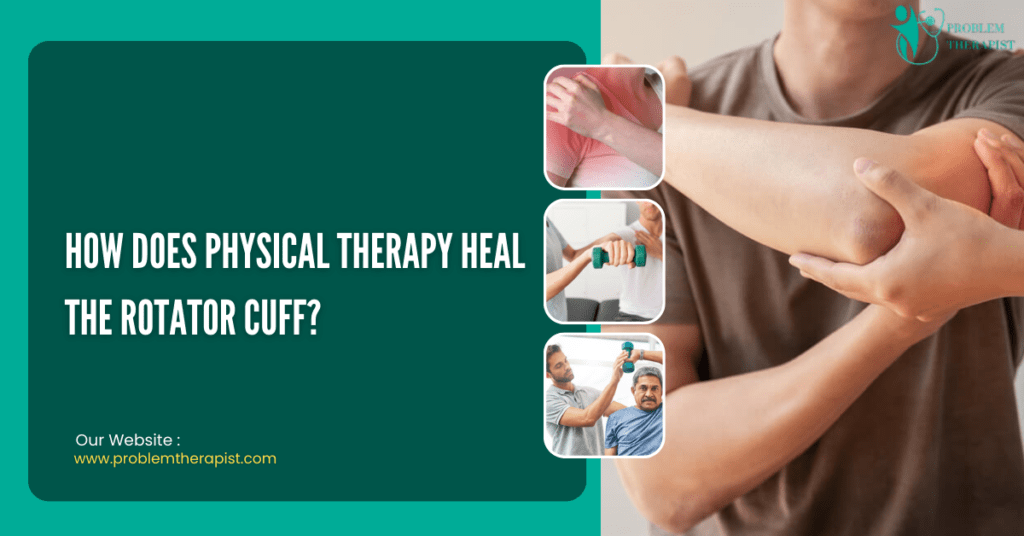Rotator cuff injuries are a common problem that can cause pain and discomfort in the shoulder. Physical therapy is one of the first treatments suggested for rotator cuff injuries. It can help restore flexibility and strength to your shoulder by providing exercises tailored to the specific location of your rotator cuff injury. Physical therapy is also an important part of the recovery process after rotator cuff surgery. The goal of treating a rotator cuff tear is not necessarily to heal the torn tendon but to reduce pain and restore function.
In this article, we will explore how physical therapy can help heal rotator cuff injuries and what exercises are typically prescribed by physical therapists.
What is a rotator cuff injury?
The rotator cuff is a group of four muscles and tendons that surround the shoulder joint. It helps to provide stability and movement to the shoulder. Rotator cuff injuries can be caused by trauma, overuse, or degeneration.
Symptoms:
The symptoms of a rotator cuff injury can include:
- Pain in the shoulder
- Weakness in the shoulder
- Difficulty moving the shoulder
- Clicking or popping sounds in the shoulder
How does Physical Therapy help a Rotator Cuff injury?
Physical therapy can help with rotator cuff injuries in several ways, including:
- Reducing pain: Physical therapists can use a variety of techniques to reduce pain, such as ice, heat, massage, and ultrasound.
- Improving range of motion: Physical therapists can teach patients exercises to improve the range of motion in their shoulders.
- Strengthening muscles: Physical therapists can teach patients exercises to strengthen the muscles around the shoulder joint.
- Preventing future injuries: Physical therapists can teach patients exercises and activities to help prevent future rotator cuff injuries.
Physical therapy helps with postural orthostatic tachycardia syndrome
What are rehabilitation techniques for rotator cuff injuries?
Many different rehabilitation techniques can be used to treat rotator cuff injuries, and the specific techniques that are used will depend on the severity of your injury and your individual needs. However, some of the most common techniques include:
- Rest: This is important in the early stages of injury to allow the tissues to heal.
- Ice: This can help to reduce pain and inflammation.
- Compression: This can help to support the shoulder joint.
- Elevation: This can help to reduce swelling.
- Exercise: This is an important part of rehabilitation, and it can help to strengthen the muscles around the shoulder joint and improve the range of motion.
What are some exercises that physical therapists prescribe for rotator cuff injuries?
Physical therapists prescribe a variety of exercises to help heal rotator cuff injuries. The first step in treating an injured rotator cuff is restoring the range of motion. “We start them with very basic exercises to rebuild flexibility within the joint,” explains physical therapist Kelly Kinsey, MSPT, AT. Here are some exercises that physical therapists might prescribe for rotator cuff injuries:
- Over-your-head stretch: This stretch uses both arms, allowing your good shoulder to help your bad one. You’ll need a light cane or rod. “This stretch helps you better reach overhead, like when you’re putting away dishes,” says Kinsey.
- External rotation: This exercise strengthens the muscles that rotate your shoulder outward. To perform this exercise, you’ll need a resistance band. Tie one end of the band to a doorknob and hold the other end with your hand. Keep your elbow at a 90-degree angle and your upper arm against your side. Rotate your forearm outward, keeping your elbow at your side.
- Internal rotation: This exercise strengthens the muscles that rotate your shoulder inward. To perform this exercise, you’ll need a resistance band. Tie one end of the band to a doorknob and hold the other end with your hand. Keep your elbow at a 90-degree angle and your upper arm against your side. Rotate your forearm inward, keeping your elbow at your side.
- Scapular retraction: This exercise strengthens the muscles that pull your shoulder blades together. To perform this exercise, stand with your back against a wall and your arms at your sides. Squeeze your shoulder blades together and hold for 5 seconds. Relax and repeat.
- Shoulder blade squeeze: This exercise strengthens the muscles that stabilize your shoulder blade. To perform this exercise, sit or stand with your arms at your sides. Squeeze your shoulder blades together and hold for 5 seconds. Relax and repeat.
It’s important to consult your healthcare provider or physical therapist before starting these, or any other, exercises for your rotator cuff tear. Performing the exercises correctly is of utmost importance to prevent further pain or problems with your shoulders. Plus, you should do exercises that are safe for your condition. While general exercises are great, specific and focused exercises can help you quickly get back to your normal shoulder function.
Conclusion
physical therapy is an effective treatment for rotator cuff injuries. It can help relieve pain, restore function, and improve the mechanics of the shoulder joint. By targeting the smaller muscles around the shoulder, physical therapy can help compensate for damaged tendons and improve the mechanics of the shoulder joint. If you have a rotator cuff injury, consult your healthcare provider or physical therapist to determine if physical therapy is right for you.
I am a highly skilled and experienced content writer with a Doctorate in Therapy degree. With a deep understanding of the human body and a passion for health and wellness. I combines my clinical expertise and writing skills to create valuable and engaging content.



Pingback: How does physical therapy help shoulder impingement? - Problem Therapist